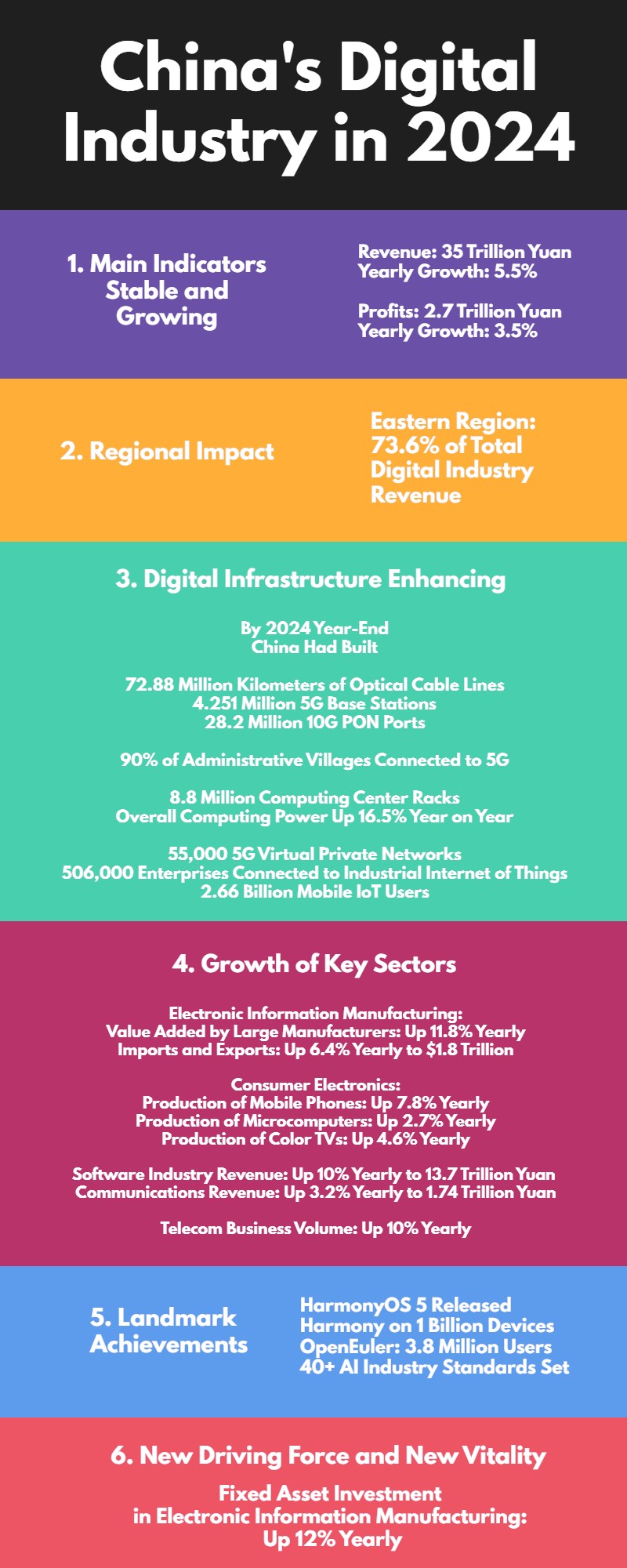
 0 Comment(s)
0 Comment(s) Print
Print E-mail China.org.cn, March 27, 2025
E-mail China.org.cn, March 27, 2025
China's digital industry showed steady growth and improved innovation in 2024, according to a Ministry of Industry and Information Technology of China (MIIT) report released on March 17.
The ministry said the sector maintained overall stability while enhancing its structure and innovative capabilities.
The report showed that in 2024, China's digital industry generated 35 trillion yuan ($4.8 trillion) in business revenue, up 5.5% year on year. Profits rose 3.5% to 2.7 trillion yuan. The sector employed 20.6 million people, roughly unchanged from 2023.
Regional growth varied across China. The eastern region saw digital sector revenue increase 6.5% year on year, accounting for 73.6% of the national total. China's central, western and northeastern regions grew by 4.2%, 0.8% and 2.5%, respectively.
Ten provinces and municipalities, including Guangdong, Jiangsu and Beijing, accounted for 81.5% of national digital industry revenue and 99.5% of total revenue growth.
The ministry also noted the emergence of national-level manufacturing clusters in areas such as information technology, artificial intelligence, display technologies and integrated circuits. These clusters are expected to drive further growth in the digital sector.
As of the end of last year, China had built a total of 72.88 million kilometers of fiber optic cables and 4.251 million 5G base stations. The country also installed 28.2 million 10G Passive Optical Network (PON) ports for homes and businesses. More than 90% of administrative villages were connected to 5G networks.
Computing centers used over 8.8 million standard racks, with overall computing power up 16.5% from the previous year. The ministry reported accelerated construction of converged infrastructure.
A total of 55,000 5G virtual private networks were put into use at industrial facilities, ports and the energy sector. The Industrial Internet of Things connected 506,000 enterprises through 381 second-level identification and resolution nodes. Mobile Internet of Things end users totaled 2.66 billion.
The report noted rapid progress toward an "intelligent world" with widespread connectivity.
In 2024, China's electronic information manufacturing sector fully recovered. Production increased rapidly, with value added by manufacturers of computers, communications and other electronic devices above designated size rising 11.8%, up 8.4 percentage points from the previous year. The sector's imports and exports totaled $1.8 trillion, a 6.4% year-on-year increase.
Production of mobile phones grew 7.8%, microcomputers 2.7%, and color TV sets 4.6%. Boosted by AI, cloud platforms, and other new business models, the software industry generated 13.7 trillion yuan in revenue, up 10% from 2023. The communications industry earned 1.74 trillion yuan, a 3.2% increase. Total business volume in the telecommunications industry grew 10% year on year.
Key industrial chains developed well, achieving notable results. Huawei released its HarmonyOS 5 system, becoming the third most popular mobile operating system after iOS and Android. The open-source Harmony system was installed on more than 1 billion devices. The openEuler system also gained over 3.8 million users. More than 40 key standards were formulated for the AI industry.
Fixed asset investment in electronic information manufacturing grew 12% year on year, driven by global demand recovery and government policies to boost consumption, upgrade industries, and enhance national security and strength.
AI, robotics and other emerging sectors became investment hotspots. AI technologies made significant progress, with large AI models quickly commercialized. AI applications in finance, government services, health care and manufacturing helped enterprises improve effectiveness and efficiency.
The combination of AI technologies and intelligent hardware generated new popular consumer products. AI-powered mobile phones gained market share rapidly.
Digital enterprises expanded globally, with consumer electronics becoming increasingly competitive in overseas markets. Digital technology service providers also actively explored business opportunities with Belt and Road cooperation partners.
